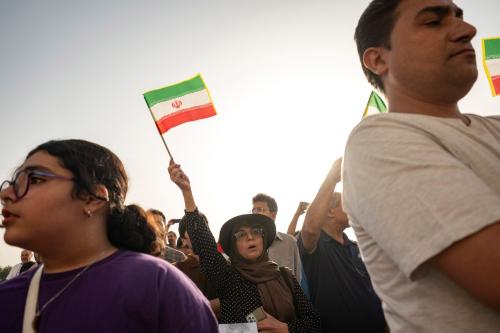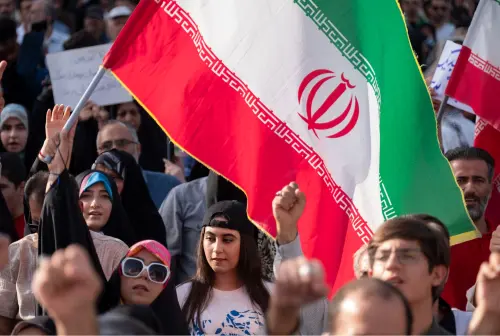Content from the Brookings Doha Center is now archived. In September 2021, after 14 years of impactful partnership, Brookings and the Brookings Doha Center announced that they were ending their affiliation. The Brookings Doha Center is now the Middle East Council on Global Affairs, a separate public policy institution based in Qatar.
Editors’ Note: Outside the Gulf, coalition members have been finding it increasingly difficult to garner public support for the Saudi-led war in Yemen, writes Sultan Barakat. This makes the deployment of coordinated and organized troops particularly challenging. This post originally appeared on Al Jazeera.
As the week-long truce in Yemen coincides with the wrapping up of the scheduled peace talks, the Saudi Arabia-led coalition should take a moment to examine emerging fault-lines within its ranks, which have become particularly evident in the most recent offensive on Taiz.
Outside the Gulf, coalition members have been finding it increasingly difficult to garner public support for the war, making the deployment of coordinated and organized troops particularly challenging.
Additionally, serious consideration should be given to the attitudes of some coalition partners, particularly the United Arab Emirates and Egypt, towards the Muslim Brotherhood (MB)—represented in Yemen by the al-Islah party.
Symbolic value
Taiz city is highly symbolic. It was the first city in Yemen to rise against Ali Abdullah Saleh during the Arab Spring, with the city’s “Freedom Square” becoming an emblem of the revolution.
After the coalition redeemed Aden during the war, the Houthis quickly tightened their grip on Taiz, considering the city a symbol of their continued power in the south. This resulted in what the International Committee of Red Cross called a “catastrophic siege” that symbolized the brutality of the war, with the city’s hilltops and outskirts in the hands of the Houthis, its center in the grip of al-Islah-led militias, and its 200,000 civilians facing severe shortages in water, food, electricity, and medical care.
On November 16, coalition forces sent major reinforcements to Taiz in a renewed effort to break the months-long siege. Taiz became the coalition’s “gateway” to Sanaa.
Today, the city serves yet another symbolic role—as a proving ground for the unity of the Saudi-led coalition, testing the pragmatism of the anti-MB crackdown launched by Saudi and the UAE after the Arab Spring.
With its Sunni majority population, the city is known as an al-Islah stronghold. In fact, it was al-Islah member Hamoud Saeed al-Mikhlafi who rose to prominence in the early days of the uprising and led the popular resistance committees that drove Saleh out of Taiz.
Shortcomings on the ground
As it stands, the coalition is vulnerable to division along more than one internal fault-line. Those fault-lines challenge its ability to win the war—along with moral questions—and, more importantly, to cultivate peace.
First, although many countries willingly joined the coalition in its early days, few have been eager to contribute the troops necessary for the operations on the ground. In fact, the majority (outside the Gulf) are finding it increasingly difficult to sustain domestic support for the war.
Nine months after the war began, a growing number of people in countries such as Jordan, Morocco, and even Egypt consider the conflict a distant war that is not theirs to fight. Given its growing tension with Iran, even Saudi may hesitate to invest further in Yemen as events unfold in Syria and Iraq.
Secondly, the few non-Gulf countries contributing soldiers, such as Sudan, and allegedly Mauritania and Senegal, have not worked together before under united command, which makes coordination potentially difficult.
The protection of civilians will prove particularly challenging given some coalition partners’ history of disregard for the laws of war. This raises questions about the “price Yemeni civilians might pay in the course of these military operations”.
In fact, the coalition has allegedly turned to hiring private security firms to supply personnel, furthering civilian protection concerns as conflicting motives and objectives creep into the mission.
Finally, and most importantly, the coalition is split over its vision for Yemen’s political future and, in particular, over the place of al-Islah and individuals such as al-Mikhlafi in any political outcome.
Before embarking on peace negotiations, the coalition should agree on how to deal with al-Islah and its political ambition. Al-Islah’s influence in Yemen is obvious. Al-Mikhlafi remained prominent and even after Yemeni President Abd Rabbu Mansour Hadi appointed Shawki Hayel Saeed as governor, he continued to act as arbitrator in local disputes and his militias remained relatively powerful.
In his two-year term, Saeed, a former chief financial officer assigned by Hadi in an attempt to make governance in Taiz “apolitical” and “technocratic”, tried to resign from his role three times out of frustration with al-Islah’s tactics.
Varying interests
Yet today, despite their role in keeping Taiz out of the control of the Houthis, al-Islah has been accused of “betrayal”, with the UAE minister of foreign affairs, Anwar Gargash, tweeting: “Had it not been for the failure of al-Islah and the [MB] to act, [Taiz would have already been] liberated.”
While Saudi Arabia considerably softened its anti-MB stance since the arrival of King Salman—partly in response to its escalating rivalry with Iran and partly owing to its historical support for al-Islah religious-tribal leaders since the 1960s—two important members of the coalition, the UAE and Egypt, have, if anything, renewed their animosity towards the movement.
The UAE, which launched a harsh crackdown on the movement in 2012 imprisoning up to 200 alleged MB-sympathizers, continues to list the group as a terrorist organization.
Today, UAE senior officials appear to see their war not just against “groups supporting a sectarian Iranian scheme” but also against those “adopting the ideology of the [MB]”.
Similarly, Egypt’s Abdel Fattah el-Sisi’s government is fervently anti-MB and is, therefore, often perceived to be coordinating with the UAE.
Conversely, Qatar was traditionally supportive of al-Islah until it recently adopted what some are characterizing as a less active foreign policy in the region. It is therefore inclined to side with Saudi, if the latter adopts more pragmatic policies towards the group.
Other key coalition members, such as Morocco, Jordan and Kuwait, are also likely to approach al-Islah pragmatically. Despite some imprisonments and restrictions imposed on local MB sympathizers, all three countries have learned to tolerate the group domestically.
Still, given the key role assumed by the UAE in Yemen, where they are increasingly perceived as “the ones in charge,” the Saudis cannot afford to alienate them.
Riyadh needs to find a way to include al-Islah in its attempts to end the conflict and assuage fears in Abu Dhabi and Cairo concerning the MB’s long-term agenda. A “managed” alliance with al-Islah could bring security to the Gulf, both in Yemen and elsewhere, as the rivalry between Iran and Saudi continues to grow.
The Brookings Institution is committed to quality, independence, and impact.
We are supported by a diverse array of funders. In line with our values and policies, each Brookings publication represents the sole views of its author(s).




Commentary
Could the Saudi-led coalition in Yemen be fracturing?
December 29, 2015